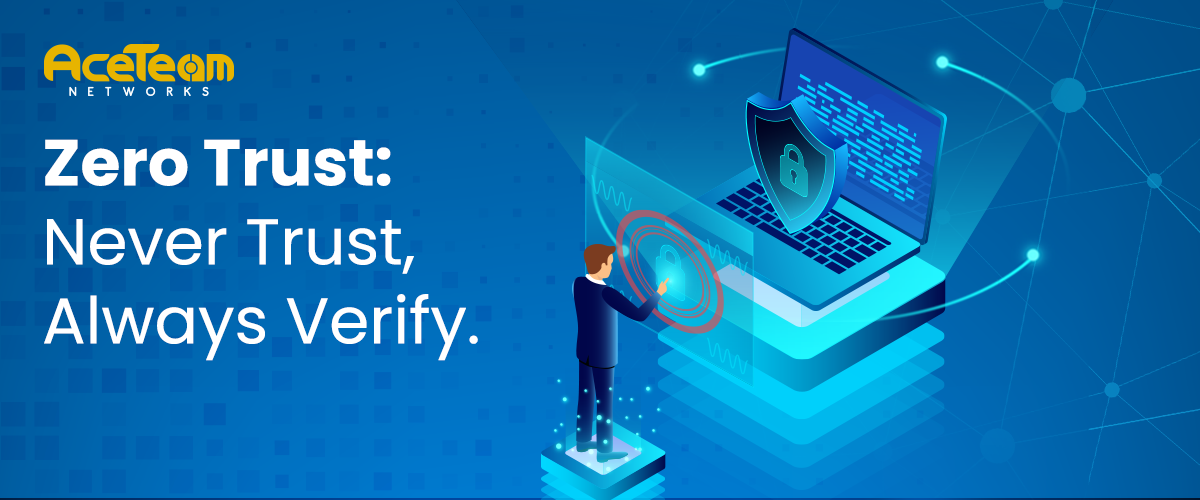Introduction
In today’s security landscape, enterprises can no longer afford to take a reactive approach to threats. They need to be proactive to detect and prevent cyber-attacks before they happen. This is where the Zero Trust security model comes in. Zero Trust is not a single product or solution, but rather a set of principles that enterprises can use to build a more secure environment.
So, what is Zero Trust and how is it implemented?
The principles of Zero Trust are simple: Never trust; always verify. Zero Trust is a security concept based on the belief that no one should be automatically trusted, regardless of their location or relationship to the organization. This includes both external users and internal users, such as employees, contractors, and third-party vendors. Zero Trust networks do not have a traditional perimeter; instead, they rely on micro-segmentation to segment network traffic into different security zones. Users are only given access to the resources they need, and their access is continuously monitored and verified. This approach to security is necessary in today’s world because networks are no longer static; they are constantly changing and evolving, making it impossible to properly secure them using traditional methods. Zero Trust is the best option to ensure that all users, regardless of location, are properly authenticated and allowed before being given access to sensitive data.
To implement a zero-trust security strategy, enterprises need to adopt a new set of technologies and processes, such as user identity and access management (IAM), data encryption, and micro-segmentation. When combined, these components can help to keep unauthorized users out while also giving allowed users the access they need to do their jobs. As more employees get used to hybrid working environments following the COVID-19 pandemic, enterprises are turning to zero-trust architecture to keep their data secure.
Why Zero Trust?
In a world where hackers are always looking for vulnerabilities, Zero Trust provides peace of mind with its innovative cybersecurity solutions that improve security and reduce costs. Explores the 6 significant benefits of shifting away from the traditional network security layer and embracing a modern, identity-based Zero Trust architecture.
1. Greater Visibility
Zero Trust enables organizations to see everything that’s happening across the enterprise because a trust-based approach assumes no one or anything is trusted; you decide what needs protecting based on criticality and risk levels in your organization. This helps avoid exposure to ephemeral resources like containers – which are becoming increasingly popular with modern cloud services providers who struggle mightily when managing these types of environments due to their lack of visibility into legacy platforms left behind by previous technologies.
2. Simplify IT Management
Zero Trust simplifies IT management because it rests on a foundation of continual monitoring and analytics. Automation allows you to automate approval processes for low-risk key identifiers, ensuring that access requests are always granted quickly with minimal human intervention required — instead of waiting around in line or risking being judged as suspicious by having your request delayed indefinitely while an analyst checks out what’s going down.
3. Improve Data Protection
Zero trust frameworks combined with just-in-time (JIT) access can prevent social engineering or malware from gaining full control of your network. If any security breach occurred, it could efficient find customer data and intellectual property before any damage is done – protecting both you as an organization and most importantly its clients who rely on the security measures put into place by these companies everyday, so they don’t get hacked too.
4. Secure Remote Workforce
KuppingerCole’s new research shows that half of the office workers use their company asset, e.g., laptop, for personal used purpose and 84% concern this increases the risk of a security breach. Zero Trust helps to approach for protecting both employees and company data by identifying who has access to what kind of information while also keeping track of where it’s going – all without relying solely upon firewalls which have become common place these days with users spread across different locations worldwide or files uploaded into cloud servers.
5. Achieve Continuous Compliance
Zero Trust architecture not only helps support continuous compliance by evaluating and logging every access request but also increases the speed with which you can uphold governance. This is because each time a new audit arises – all related data will be attached to an automatically generated chain of evidence that provides seamless reporting for both enterprise-grade security standards as well any regulatory requirements or industry best practices.
6. Lower Operational Costs
With Zero Trust Enterprise, you can rely on one access control to protect your organization from the risks of Dedicated Security Controls (DSC). This reduces not just deployment and operations costs but also complexity for users who are made more efficient by having all their security needs met in one place.
Utilize the five-step method when implementing the Zero Trust Network Architecture
1. Identify the Protect Surface
You require determining what resources need to be protected in your business network by controlling access and verifying all users and devices accessing it. This can be determined by categorizing the resources into Data, Applications, Assets, and Services (DAAS):
· Data: Credit card information, personally identifiable information, intellectual properties.
· Application: Custom or off-the-shelf software.
· Assets: Network equipment, point-of-sale terminals, medical equipment, manufacturing assets, and IoT devices.
· Services: DNS, DHCP, and identity banks.
2. Map the Transaction Flows
You require understanding the flow of data from one side of the network to another and evaluate how it interacts with other resources in the network. To better understand the flow of specific data, it’s best to start with a small portion of the network to familiarise yourself with the process while minimizing disruptions to the network.
Next-generation firewalls can also be used in monitoring to gather more precise network traffic data.
3. Pick the Right Zero Trust Infrastructure for Your Organization
Other than that, choosing whether to create a Zero Trust infrastructure from scratch or an existing one should be under consideration. Your organization should adopt by weighing the pros and cons of each and whether it suits your needs.
4. Create the Zero Trust Policy
Providing all users with complete access defeats the purpose of the Zero Trust network architecture in the first place. Determine the access policies for each staff member by using the Kipling method – which involves asking these simple questions:
· What do they need from the network?
· Who needs to access the business network?
· Where do they need to access the network from?
· When do they need to access the network?
· Why do they need to access the network?
· How are they going to access the business network?
Compile a list of devices that will access the network and to who it belongs:
· Laptop
· Desktop
· Smartphone
· Tablet
· IoT device
5. Monitor and Maintain the Network
Once Zero Trust architecture has been implemented, inspecting and logging all data traffic is vital. It provides context on what to tweak to make the network more secure.
Additionally, it provides clues on how your protect surfaces are handled and the interdependencies of the data within them.
Zero Trust Network Architectures Involves Multiple Technologies and Solution
AceTeam Networks offer Zero Trust Security solutions for businesses to secure an environment that protects against unauthorized access to sensitive data and digital assets.
Top Zero Trust Solutions:
1. Aruba
Aruba built-in Zero Trust and SASE security ensure that the same access controls applied to campus or branch networks also extend to the home or remote worker across wired, wireless, and WAN connections.
2. Palo Alto
Purpose-built in the cloud to secure today’s hybrid workforce. Palo Alto Prisma Access protects all application traffic with best-in-class capabilities while securing both access and data to dramatically reduce the risk of security breach. With policy framework and single-pane-of-glass management, Prisma Access secures today’s hybrid workforce without compromising performance, backed by industry-leading SLAs to ensure exceptional user experiences.

Conclusion
Zero Trust is not a single product or solution, but a security model that offers enterprises the controls they need to proactively detect and prevent threats in real-time. Contact us now to learn more about how our Zero Trust solutions can help your organization stay safe from today’s ever-evolving threats.





